
If you have recently read our latest post, Part I in our series, Which Balance Bike Is Best For My Child? then you will be familiar with where we have drawn inspiration and the direction this post is heading.
For those who are new here, the post you are reading is the second in our series of three that wishes to answer our headline title’s question for parents, caregivers and educators alike. Which balance bike is best for my child?
Looking back to Part I, our focus was on rider characteristics and how this will help determine the best balance bike for your little rider. In this post, Part II, our focus turns to balance bike features.
Our goal is to inform you of those key balance features to look out for when deciding which balance bike will best suit your little gem.
Here is an overview of the topics we are looking into to help us answer our title question:
Which balance bike is best for my child? Balance bike features.
- Balance bike frame: weight and materials
- Seat height range
- Adjustability: seat and handlebars
- Tires, and
- Additional Features: brake, footrests, steering limiter
As promised, we will then provide you with a brief list of balance bike options. In addition, for practical purposes we have broken these down into the following age-groups;
- Toddlers (18 months to 2 Years)
- Older toddlers (2 to 3 Years)
- Preschoolers (3 to 4 Years), and
- Older Preschoolers (4 to 5+ Years)
Our list of recommended balance bikes is specifically tailored to consider the unique balance bike features discussed in our article, allowing you to once again see the practical relevance of these when looking for that perfect riding partner for your child.
So, kick-back (with your favorite brew of course) and enjoy our latest post, Which balance bike is best for my child? Part II.
Let’s get into it!
Affiliate disclosure time: Some of the links on this page are affiliate links. If you click on those links and make a purchase within a time frame, we earn a small commission. Rest assured, the commission is paid by the retailers, not by you.
This commission helps keep ilovetoridemybike.com riding and writing. We thank you for your generous support. You are helping us continue doing what we love and that’s providing our customers with all the information they need to know about kids balance bikes
Balance Bike Features
If your familiar with our website, then you will definitely have a familiarity with the balance bike features that we highly recommend to our readers. We are sure you won’t mind seeing these again, as they are king when it comes to balance bike selection for your child.
The balance bike material is the first of several key factors to consider. Basically, this means we are looking for overall quality, durability, safety, environmentally friendly and most of all, lightweight options.
A balance bike that is super light quite simply makes learning to ride easier. This is a huge advantage for your child when first beginning to ride. Some examples of super light balance bikes include the Cruzee Ultralight (1.9kg), Little Nation (1.9kg) and Strider 12 Pro (2.5kg).
Lightweight materials such as aluminum, steel, nylon-composite or wood provide ease of maneuverability, slowing and stopping and for us parents out there, ease of transportation when our little gem has had enough for the day 🙂
Seat Height Range
Another key balance bike feature is seat height range.
To learn all about what exactly this is, and which seat height range is optimal for your child, we recommend you head on over to our Balance Bike Buyers Guide.
In that post, we unpack, with examples, how to find your child’s inseam and therefore optimal seat height. Empowered with that information, you simply need to be looking for a balance bike with a seat height range that your child’s optimal seat height falls into.
Pretty neat!
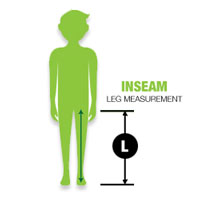 Here’s a quick example for you. If your child’s inseam is 14.5″, their optimal seat height is 13.5″ (-1″). A popular balance bike on the market is the Strider 12 Sport, which has a seat height range of 11″ – 19″. Our example rider’s optimal seat height of 13.5″ falls beautifully within this range and therefore the Strider 12 Sport would be an option for our example rider.
Here’s a quick example for you. If your child’s inseam is 14.5″, their optimal seat height is 13.5″ (-1″). A popular balance bike on the market is the Strider 12 Sport, which has a seat height range of 11″ – 19″. Our example rider’s optimal seat height of 13.5″ falls beautifully within this range and therefore the Strider 12 Sport would be an option for our example rider.
Keep in mind you ideally would like your child’s optimal seat height to fall toward the lower end of the balance bike’s seat height range, so that your child has room to grow and enjoy the balance bike for a number of years.
Adjustable Seat and Handlebars
These are two highly recommended features for a child’s balance bike.
The ability to be able to adjust the seat height and handlebar height is a great addition that allows you to customize the bike’s fit to your little rider and continue to adjust as they grow like a mushroom.
Most balance bikes will allow you to adjust the seat height. Only some however, the handlebar height.
Also, you are looking for what we describe as user-friendly functionality. Basically, this is ease of adjustability, ideally with quick-release clamps that don’t require tools, so that you can tighten or adjust quickly and efficiently.
Some examples of these great features are found on the Cruzee Ultralite, Strider 12 Sport and Strider Classic, GOMO, Baby Joy and Trike Star 12″ balance bikes.
Tires
When you are riding a bike, nothing beats the quality of the rubber that hits the road! Tire quality is a biggy when it comes to the level of comfort a rider will experience when riding their balance bike.
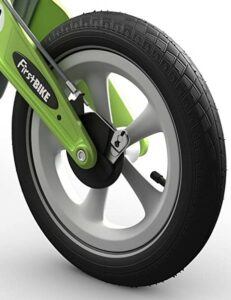
Hands down, we advocate getting a balance bike with air tires whenever possible.
The benefits of air tires include greater traction and handling on both on and off-road surfaces, and enhanced shock absorption, leading to more comfort and fun as the rider can feel more stable and confident as they explore any form of terrain.
Some examples of balance bikes that come with quality air tires include the Radio Flyer, Vuly 12″, FirstBike Cross, Banana Bike GT, smarTrike 3-in-1, and Retrospec Cub Plus.
A quick word on other tire options.
EVA foam rubber tires, although not superior in quality, comfort or handling, do serve a purpose and can be advantageous depending on your child’s riding needs.
EVA foam require no maintenance and never go flat. Specialized Hotwalk’s Rhythm Lite Airless tires are a good example of a very durable airless tire that would essentially handle any terrain almost as well (and arguably just as well) as a quality air tire.
So again, depending on your child’s riding needs these are certainly worth considering, especially if your child will be riding mostly on hard, paved surfaces and who is perhaps a little less adventurous and/or timid on a bike.
Additional Features: Brake, Footrests and Steering limiter
These three additional features are non-essential balance bike features that some bikes rock as standard.
Brakes provide an added element of control to your child’s riding, other than just using their feet to slow down or stop and provide an introduction to the handbrake that they will most likely become familiar with when they begin riding their first pedal bike.
These advantages, while great are certainly not essential if your child is a young toddler just starting to explore the world of bike riding. Slightly older toddlers or preschoolers however, who may be closer to getting a pedal bike would do well in learning the skills intuitive of a handbrake, helping to make their transition to a pedal bike with this feature a little smoother.
Some examples of balance bikes with brakes include the smarTrike 3-in-1, FirstBike Cross, Woom 1, Woom 1 Plus and Norco Runner 12.
Footrests provide a neat little platform for the rider’s feet to rest when in the gliding position. Again, not all balance bikes have this feature, as most kids will position their feet usually in front of their bodies, then behind, and finally rest these on the rear frame once they master the skill of gliding.
However, we like this feature if designed well, as this will allow the rider to safely rest their little feet into a position that creates a better gliding posture and encourage some super long free-wheeling fun!
Steering limiters are again a non-essential feature and like other additional inclusions are somewhat controversial in the balance bike world. We advocate that these are not necessary and can in fact add an element of unwanted risk when riders fall.
Steering limiters essentially allow a degree of steering for the balance bike.
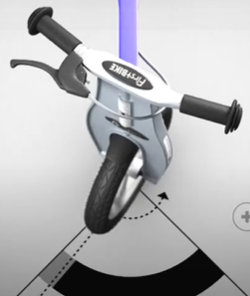
Firstbike, for example (see image) allows approximately 90 degrees of steering from the neutral (forward) position, or 45 degrees in both directions. During a fall however, this means the handlebars will be sitting up potentially causing injury.
For this reason, we advocate that these are not necessary and that a child will do well to learn to ride by keeping both hands firm yet relaxed on the handlebars at all times when riding.
We think it’s best to spend a little extra money finding a great quality, lightweight balance bike with a brake and air tires rather than seeking this feature. However, if you like the sound of the steering limiter for your child some bikes that come with this include the Woom 1 and Woom 1 Plus, FirstBike, and GOMO.
Now that we have covered the essential features to look out for when searching for the best balance bike for your child, let’s take a look at a few examples, per age-group, that considers these features.
Balance Bike Options Per Age Group
Toddlers (18 months to 2 Years)
Bike: Banana Bike LT
Where to Buy: Amazon.com (USA $78) and Amazon.com.au ($394)
Frame – Weight and Materials: Lightweight steel alloy (6.4lbs or 2.9kg)
Seat Height Range: 12.2″ to 15.7″
Adjustable Seat and Handlebars: Yes to both
Tires: EVA foam rubber
Additional Features: No brake, footrests or steering limiter
Overall Rating: 7 / 10
This is a solid performing, no frills budget option balance bike. Great for smaller, lighter, less adventurous rider’s just starting their bike riding journey.
Bike: Woom 1
Where to Buy: Woom.com (US $199)
Frame – Weight and Materials: Lightweight, high-quality aluminum (6.6lbs or 3.0kg)
Seat Height Range: 10″ to 14″
Adjustable Seat and Handlebars: Adjustable seat only
Tires: Air tires with Schradar (car type) valves
Additional Features: brake included and a removable, rubber ring steering limiter. No footrests
Overall Rating: 9.5 / 10
A top-quality bike with great features. Your little gem will love this bike.
Older Toddlers (2 to 3 Years)
Bike: Vuly 12″ Balance Bike
Where to Buy: vulyplay.com (AUS $149)
Frame – Weight and Materials: Magnesium alloy frame and forks (3.2kgs)
Seat Height Range: suits inseam length 300mm to 430mm or kids 90 to 102cm tall
Adjustable Seat and Handlebars: Adjustable seat only
Tires: air tires
Additional Features: no brake or steering limiter, quality design footrests
Overall Rating: 7.5 / 10
This is a great quality bike with some nice features. Handles quite well over on and off-road terrain.
Bike: Banana Bike GT
Where to Buy: amazon.com (US $80) or amazon.com.au (AUS $386)
Frame – Weight and Materials: alloy steel (3.5kgs or 8.1lbs)
Seat Height Range: 12.5″ to 17″
Adjustable Seat and Handlebars: adjustable seat and handlebars
Tires: air tires
Additional Features: no brake, steering limiter or footrests
Overall Rating: 7.5 / 10
A solid performing budget bike with the additional comfort of air tires.
Preschoolers (3 to 4 Years)
Bike: Woom 1 Plus
Where to Buy: woom.com (US $269)
Frame – Weight and Materials: Lightweight AA 6061 aluminum frame (9.5lbs or 4.5kg)
Seat Height Range: 15″ to 19″
Adjustable Seat and Handlebars: adjustable seat only (quick-release clamp)
Tires: 14″ air tires with Schradar (car-type) valves
Additional Features: front and rear handbrake, detachable rubber ring steering limiter and surfboard footrest
Overall Rating: 9.5 / 10
A high-quality bike with all the extra features. Like the Woom 1, your child will love this bike!
Bike: smarTrike 3-in-1 Xtend
Where to Buy: smartrike.com (USD $224)
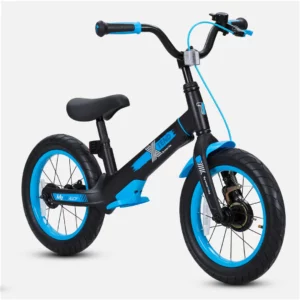
Frame – Weight and Materials: Lightweight magnesium frame (14.75lbs as a balance bike / 18.36lbs with pedal kit)
Seat Height Range: 15″ to 21″
Adjustable Seat and Handlebars: adjustable seat and handlebar
Tires: 14″ air tires
Additional Features: front handbrake (rear coaster as a pedal bike), no steering limiter or footrest. This is the only extendable bike on the market, converting from a balance to pedal bike, then larger pedal bike as you extend the frame.
Overall Rating: 7.5 / 10
a great bike for preschoolers still needing a balance bike for another 12+ months before stepping up to a pedal bike. Great for parents looking for a low-cost option that fulfills the transition from balance to pedal bike.

Older Preschoolers (4 to 5+ Years)
Bike: Strider 14x Sport Convertible Balance Bike
Where to Buy: Amazon.com (USD $200) and Amazon.com.au (AUS $663)
Frame – Weight and Materials: steel frame (Balance bike: 5.7kg / 12.5lbs and Pedal bike: 6.9kg / 15.1lbs)
Seat Height Range: 15″ to 22″
Adjustable Seat and Handlebars: Yes to both. Tool adjustable handlebars and quick-release clamp adjustable seat
Tires: Schradar valve 14″ air tires
Additional Features: no brake in balance bike mode, coaster brakes in pedal mode
Overall Rating: 8 / 10
Performs really well as a balance bike, and quite well for smaller, slightly shorter rider’s in pedal mode due to the shorter crank lengths and smaller pedals.
Bike: Bixe 16″ Balance Bike
Where to Buy: Amazon.com (USD $110) and Amazon.com.au (AUS $222)
Frame – Weight and Materials: lightweight steel frame (5.4kg / 12lbs)
Seat Height Range: 18.25″ to 22.25″
Adjustable Seat and Handlebars: Yes to both. NOTE: Tool required to adjust both seat and handlebars
Tires: 16″ air tires
Additional Features: Yes, footrests included however no brake or steering limiter.
Overall Rating: 7 / 10
This is one of only three 16″ balance bikes on the market, and rides really well with its air tires. The tool required seat and handlebar adjustments can be problematic and the lack of handbrake, especially for older preschoolers who are beginning to gain some speed. Overall, this bike is a really light, descent performer.
Overall ilovetoridemybike.com conclusion
Thanks for reading this far into our post. We hope that you found this useful and that you’re feeling well-educated on the balance bike features to look out for when looking for a balance bike to suit your child.
A quick re-cap of what we have covered with you in our post, Part II – Which balance bike is best for my child?
We looked at key balance bike features including:
- frame: weight and materials
- seat height range
- adjustability: seat and handlebars
- tires, and
- additional features to look out for including brakes, footrests and steering limiter
Our next post, Part III is our final in our series and will cover Riding Environments, to help us provide you with a comprehensive answer to our title question, which balance bike is best for my child?
If you have any questions or comments, please leave these below, we are more than happy to help and love to hear everything about your child’s bike riding experiences.
Happy riding!
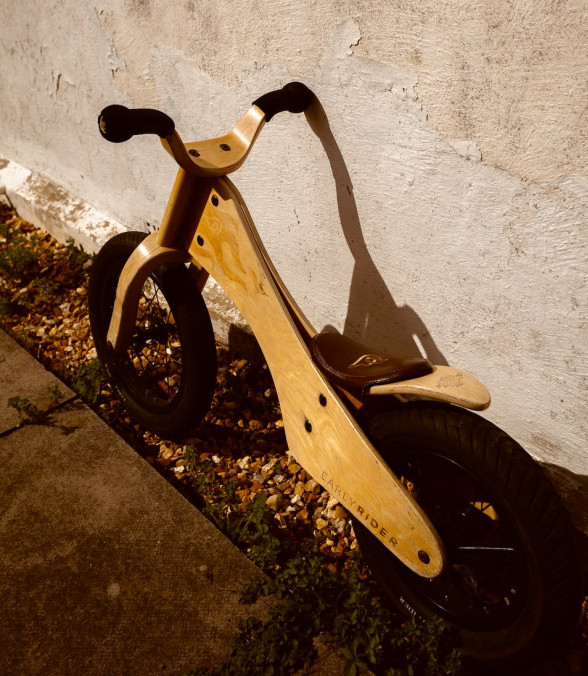




Your detailed explanations and examples of how to find the optimal seat height range for your child and which balance bikes meet that criteria were very helpful. Also, the information about air tires and the benefits they provide in terms of greater traction and handling on both on and off-road surfaces and enhanced shock absorption is valuable.
I commend your effort to provide a brief list of balance bike options specifically tailored to consider the unique balance bike features discussed in your article, allowing parents and caregivers to see the practical relevance of these features when looking for the perfect riding partner for their child.
Hi Anoth,
Thanks for your comments, we value your feedback and are glad you found this useful. Please follow and share our website and of course send us through any further questions you may have regarding the world of balance bikes.
Happy riding to you!
I just read your post about choosing the best balance bike for children and I have to say, I found it to be very informative and helpful. As someone who’s always been interested in promoting active and healthy lifestyles for children, I appreciate the emphasis you placed on the benefits of balance bikes and the factors to consider when choosing one.
One thing that stood out to me was the importance of adjustable features, such as seat height and handlebar position. This is important for ensuring that the bike is comfortable and safe for the child to ride, and can be adjusted as they grow and develop.
I also appreciated the emphasis you placed on lightweight and durable construction, which makes it easy for children to manoeuvre and control the bike, while also ensuring that it can withstand the wear and tear of regular use.
I also think it is important to have a comfortable and ergonomic design, including things such as padded seats and grips. This is important for ensuring that the child enjoys their riding experience and is motivated to continue riding and improving their skills.
Overall, I think that your post is a great resource for parents and caregivers looking to choose the best balance bike for their child. The emphasis on adjustable features, lightweight and durable construction, and comfortable design are all important factors to consider when choosing a bike that will promote a love of cycling and a healthy, active lifestyle. Thank you for sharing your expertise and insights with us!
Hi Julia, thank you so much for your detailed and thorough comments for us.
We really appreciate your feedback and are delighted to hear that our post was helpful. We do have so much knowledge to share with everyone wanting to learn more about kids balance bikes, and our passion is as endless as our expertise.
The features you have mentioned are so important to ensure we match the right balance bike to the right rider, so that their experiences can be so much more fun and rewarding, keeping their interest and passion for riding at this crucial age and stage of their development.
Please reach out to us if you have any questions and/or wish to share your riding experiences with us. Happy riding, and thanks again for following us.